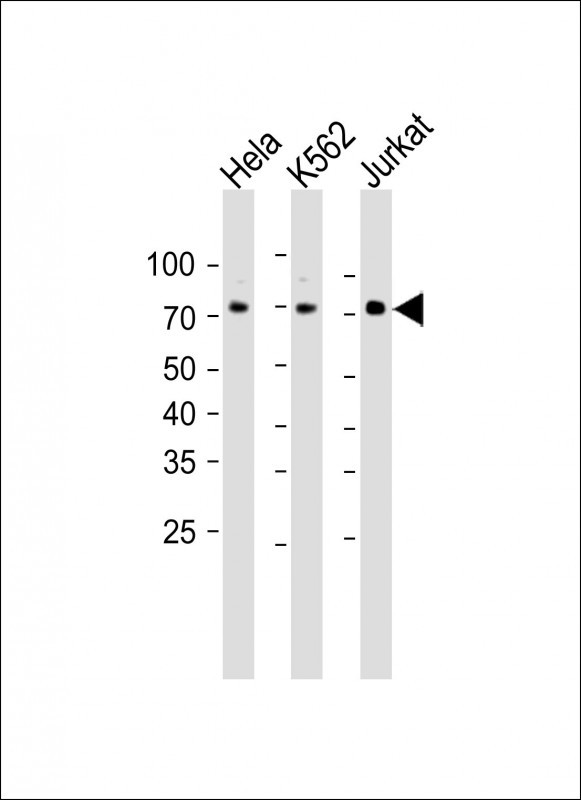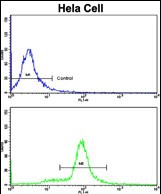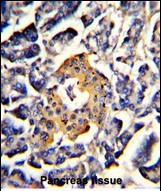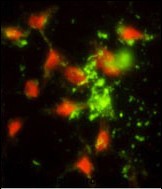SRP72 Antibody (Center)
Affinity Purified Rabbit Polyclonal Antibody (Pab)
- 产品详情
- 实验流程
- 背景知识
Application
| WB, FC, IHC-P, IF, E |
|---|---|
| Primary Accession | O76094 |
| Reactivity | Human |
| Host | Rabbit |
| Clonality | Polyclonal |
| Isotype | Rabbit IgG |
| Calculated MW | 74606 Da |
| Antigen Region | 119-148 aa |
| Gene ID | 6731 |
|---|---|
| Other Names | Signal recognition particle subunit SRP72, SRP72, Signal recognition particle 72 kDa protein, SRP72 |
| Target/Specificity | This SRP72 antibody is generated from rabbits immunized with a KLH conjugated synthetic peptide between 119-148 amino acids from the Central region of human SRP72. |
| Dilution | WB~~1:2000 FC~~1:10~50 IHC-P~~1:100~500 IF~~1:10~50 E~~Use at an assay dependent concentration. |
| Format | Purified polyclonal antibody supplied in PBS with 0.05% (V/V) Proclin 300. This antibody is purified through a protein A column, followed by peptide affinity purification. |
| Storage | Maintain refrigerated at 2-8°C for up to 2 weeks. For long term storage store at -20°C in small aliquots to prevent freeze-thaw cycles. |
| Precautions | SRP72 Antibody (Center) is for research use only and not for use in diagnostic or therapeutic procedures. |
| Name | SRP72 |
|---|---|
| Function | Component of the signal recognition particle (SRP) complex, a ribonucleoprotein complex that mediates the cotranslational targeting of secretory and membrane proteins to the endoplasmic reticulum (ER) (PubMed:34020957). The SRP complex interacts with the signal sequence in nascent secretory and membrane proteins and directs them to the membrane of the ER (PubMed:34020957). The SRP complex targets the ribosome-nascent chain complex to the SRP receptor (SR), which is anchored in the ER, where SR compaction and GTPase rearrangement drive cotranslational protein translocation into the ER (PubMed:34020957). Binds the signal recognition particle RNA (7SL RNA) in presence of SRP68 (PubMed:21073748, PubMed:27899666). Can bind 7SL RNA with low affinity (PubMed:21073748, PubMed:27899666). The SRP complex possibly participates in the elongation arrest function (By similarity). |
| Cellular Location | Cytoplasm. Endoplasmic reticulum |
For Research Use Only. Not For Use In Diagnostic Procedures.
Provided below are standard protocols that you may find useful for product applications.
BACKGROUND
Signal-recognition-particle assembly has a crucial role in targeting secretory proteins to the rough endoplasmic reticulum membrane. It binds the 7S RNA only in presence of SRP68. This ribonucleoprotein complex might interact directly with the docking protein in the ER membrane and possibly participate in the elongation arrest function.
REFERENCES
Utz,P.J., et.al., J. Biol. Chem. 273 (52), 35362-35370 (1998)
终于等到您。ABCEPTA(百远生物)抗体产品。
点击下方“我要评价 ”按钮提交您的反馈信息,您的反馈和评价是我们最宝贵的财富之一,
我们将在1-3个工作日内处理您的反馈信息。
如有疑问,联系:0512-88856768 tech-china@abcepta.com.
|
Anonymous
2016-08-24 09:20:44
1
2
3
4
5
|
Species tested
Human,Mouse
Application tested
WB
Organization tested
Hela,K562,Jurkat,TE-1,LO2,U87,Liver(M),Brain(M),Liver(R)
Barcode encoding
Brief protocol
1. Block with 3% skim milk for 1 hour at room temperature.
2. Incubate overnight with Abgent primary antibody 1:1000 in 3% skim milk at 4℃
3. Wash 5*5 min with TBST.
4. Incubate with HRP-conjugated secondary antibody 1:5000 in 3% skim milk for 1 hour at room temperature.
5. Wash 5*5 min with TBST.
6. Incubate with ECL substrates and expose
|























 癌症的基本特征包括细胞增殖、血管生成、迁移、凋亡逃避机制和细胞永生等。找到癌症发生过程中这些通路的关键标记物和对应的抗体用于检测至关重要。
癌症的基本特征包括细胞增殖、血管生成、迁移、凋亡逃避机制和细胞永生等。找到癌症发生过程中这些通路的关键标记物和对应的抗体用于检测至关重要。 为您推荐一个泛素化位点预测神器——泛素化分析工具,可以为您的蛋白的泛素化位点作出预测和评分。
为您推荐一个泛素化位点预测神器——泛素化分析工具,可以为您的蛋白的泛素化位点作出预测和评分。 细胞自噬受体图形绘图工具为你的蛋白的细胞受体结合位点作出预测和评分,识别结合到自噬通路中的蛋白是非常重要的,便于让我们理解自噬在正常生理、病理过程中的作用,如发育、细胞分化、神经退化性疾病、压力条件下、感染和癌症。
细胞自噬受体图形绘图工具为你的蛋白的细胞受体结合位点作出预测和评分,识别结合到自噬通路中的蛋白是非常重要的,便于让我们理解自噬在正常生理、病理过程中的作用,如发育、细胞分化、神经退化性疾病、压力条件下、感染和癌症。










